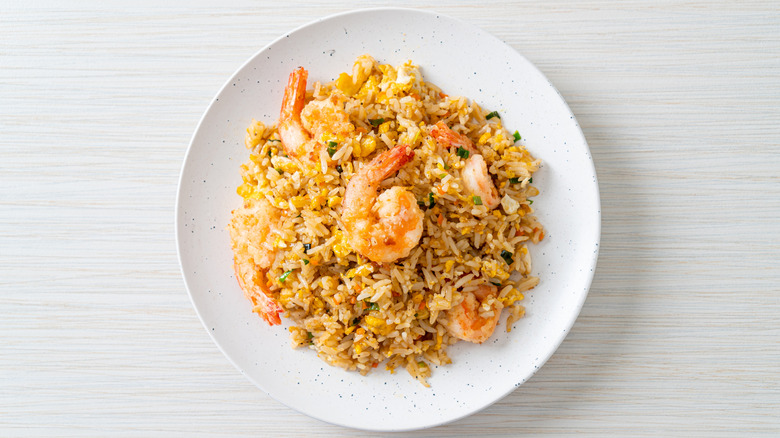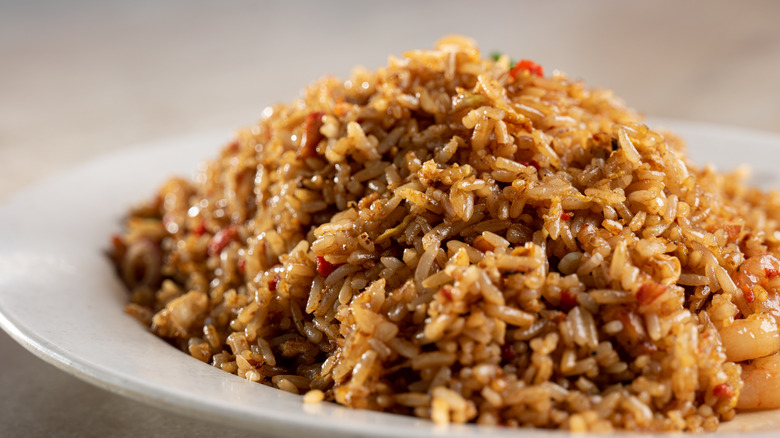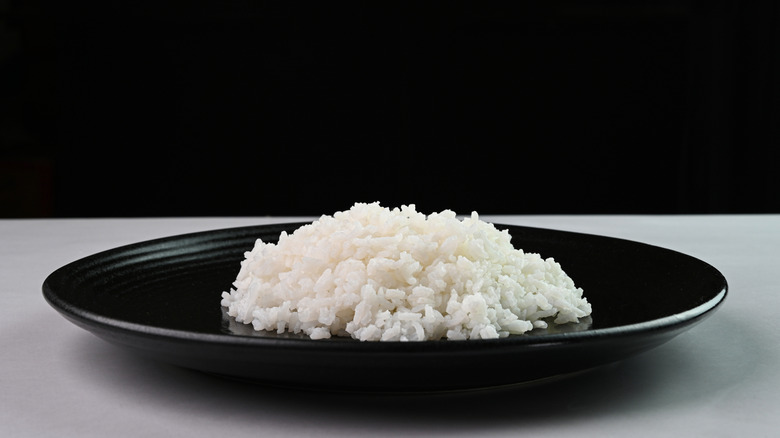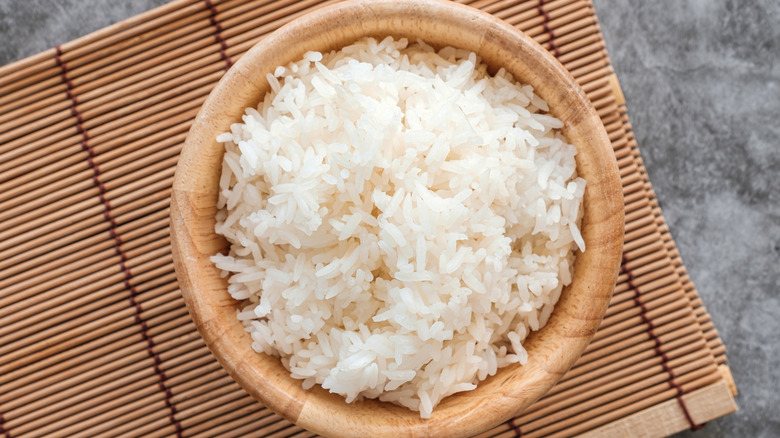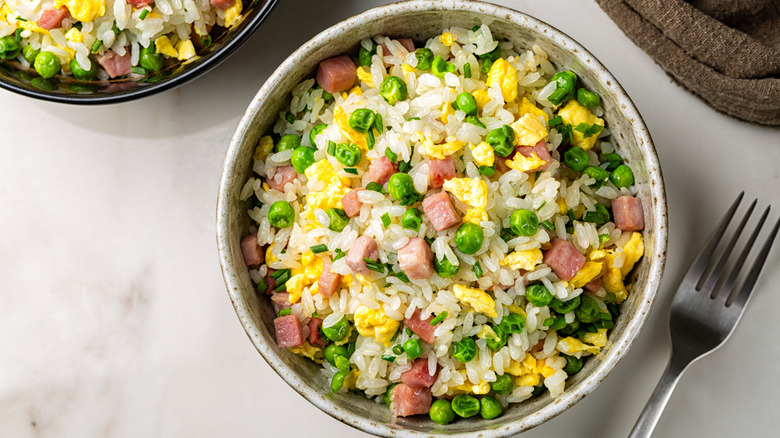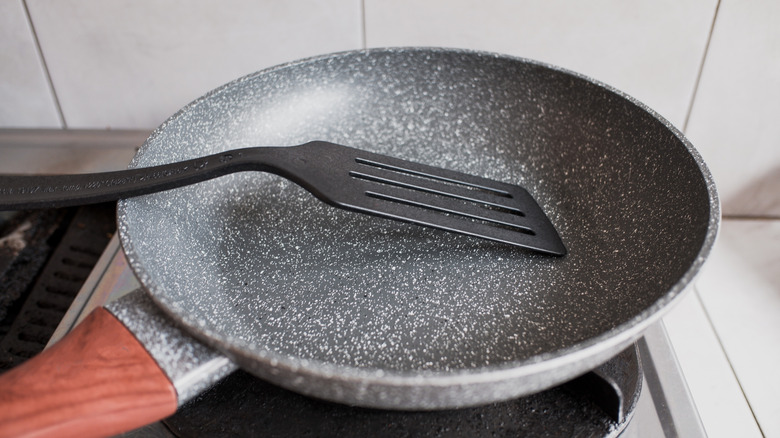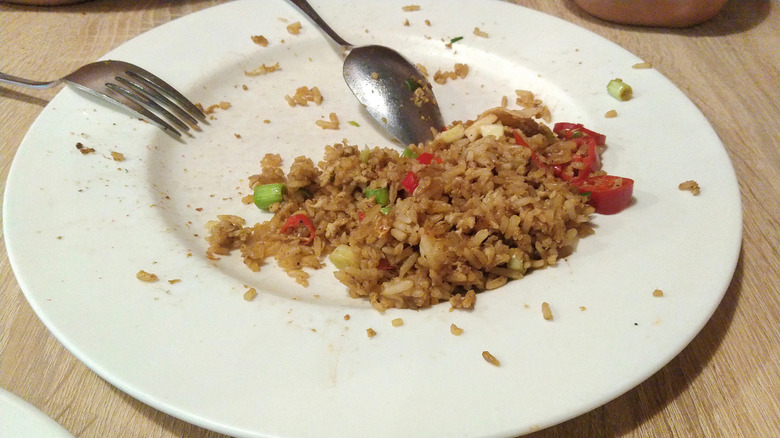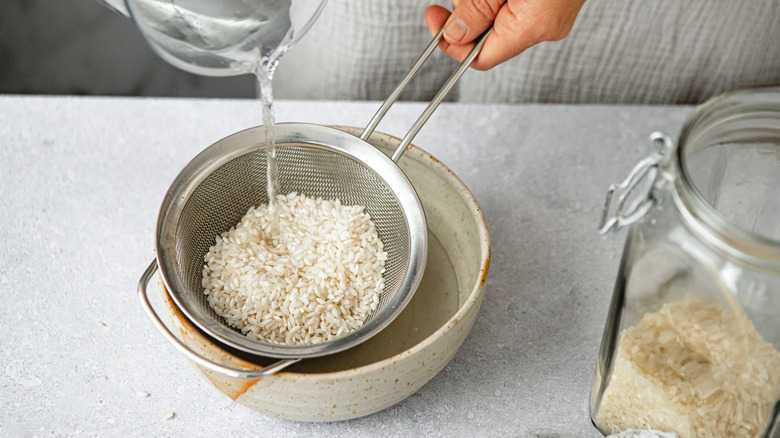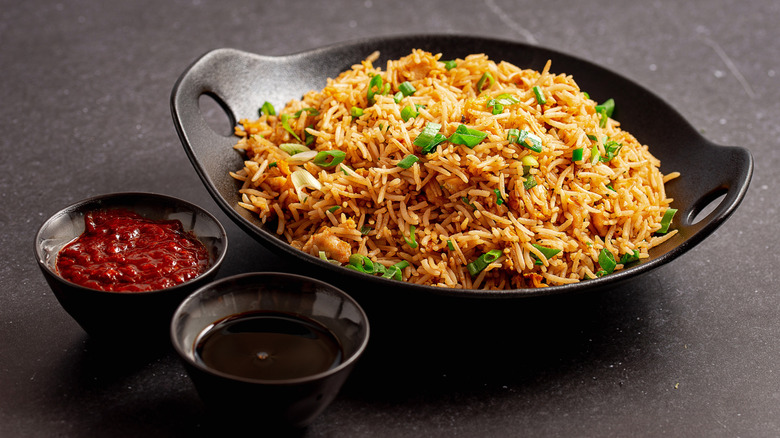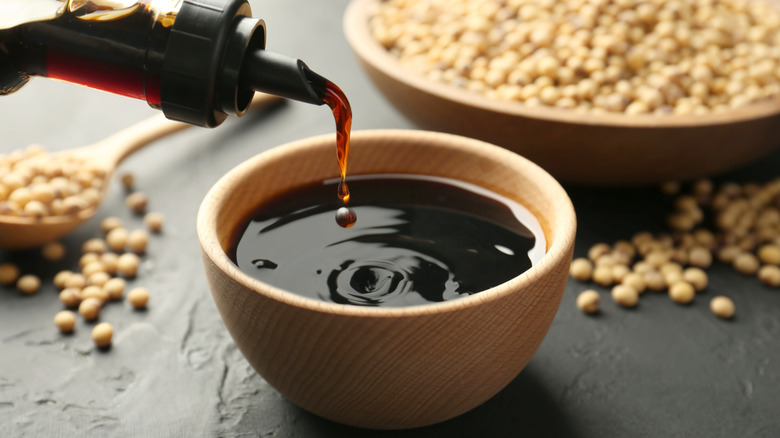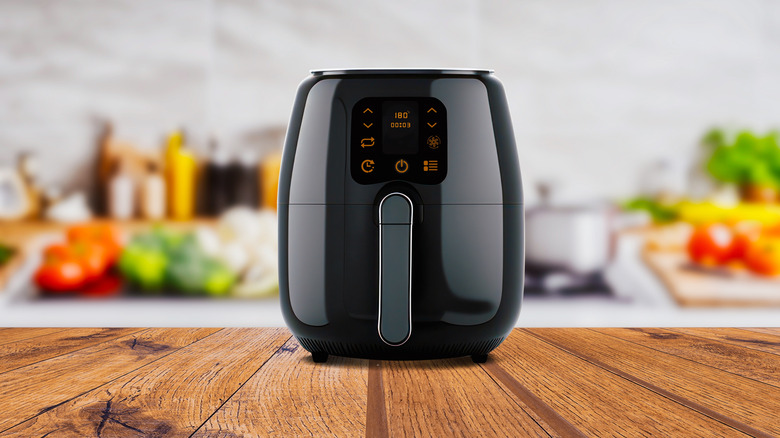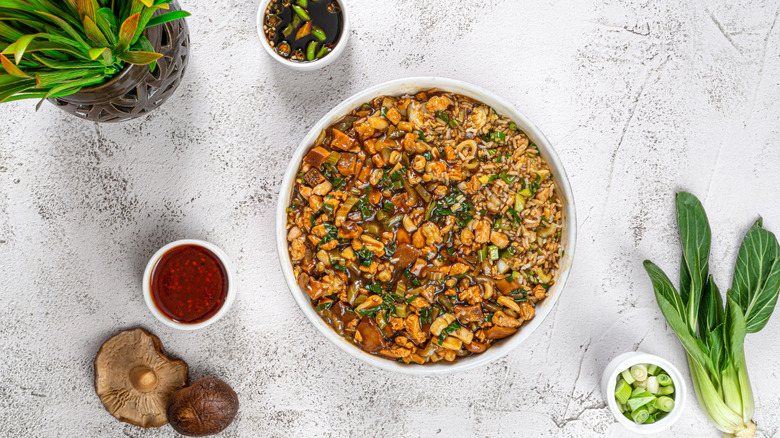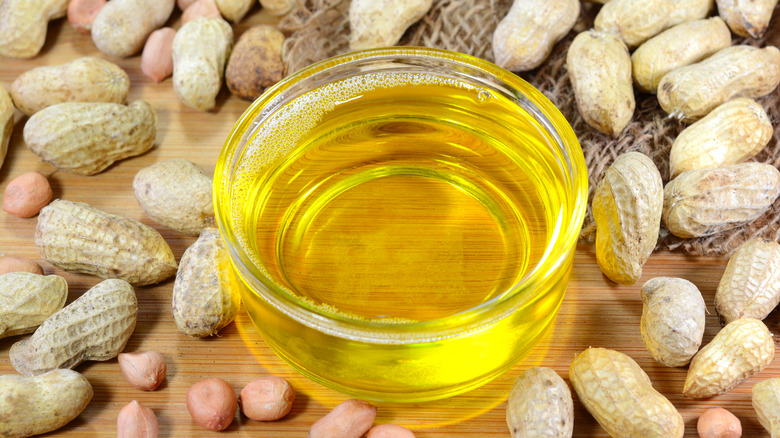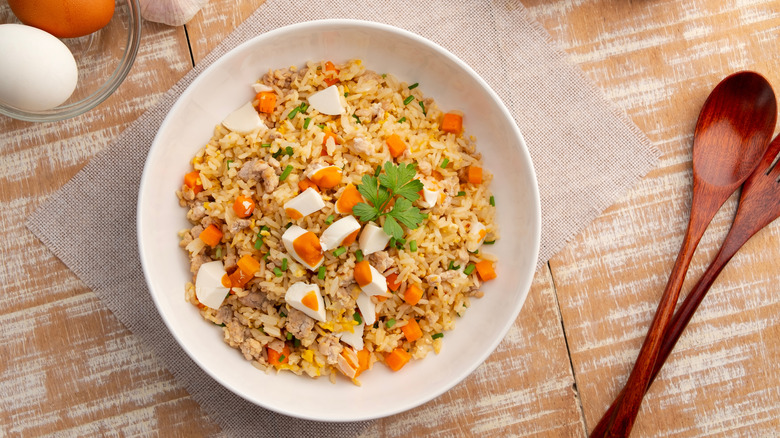13 False Facts About Fried Rice You Thought Were True
We may receive a commission on purchases made from links.
Fried rice is one of those dishes that pretty much everyone loves. An infinitely tasty combination of rice, veggies, and proteins fried with oil and seasonings, it's a simple dish that doesn't seem as though it would cause any controversy. Yet throughout the thousands of years that fried rice has been around, some persistent false facts have developed about it which have been handed down from person to person. For such a straightforward dish, fried rice has a fairly rigorous belief system around it, with many folks remaining incredibly rigid about the best ways to cook it and decrying any alternative methods.
False facts about fried rice aren't just related to how you make it, though. There are a lot of myths out there about the nutritional quality of fried rice, which have influenced generations upon generations of people to assume the worst with this dish. A lot of misinformation also exists about how safe it is to eat once you've cooked it and how best to store it. Ready to find out the truth about this timeless meal? Grab your spoon, and let's go.
1. False: Fried rice is always unhealthy
Fried rice is a takeout staple, and perhaps because of this it's developed an unfair reputation for always being unhealthy. However, this really isn't the case. Sure, there's no accounting for the nutritional quality of takeout fried rice, and certain kinds can be pretty oily or high in sodium, or may be lacking in vegetables or substantial protein. However, it's worth bearing in mind that fried rice is a dish that's composed of whole foods and you can cram it full of vitamins, minerals, fiber, lean proteins, healthy fats, and complex carbohydrates. Making fried rice also requires far less fat than you probably think, especially if you use a well-seasoned or nonstick wok.
You can also make simple swaps with homemade fried rice to make it more nutritious. If you opt for brown rice over white rice, you'll gain more fiber and protein. Instead of using fatty or red meat, opt for proteins like chicken breast or tofu. Try to balance out the amount of rice you use with a healthy portion of vegetables to keep it both wholesome and filling. The possibilities to customize this dish are endless, folks.
2. False: You have to cook your rice the day before
One of the biggest false facts out there about fried rice concerns how you prepare the rice itself. Common knowledge dictates that if you want the best fried rice, you have to cook your rice the day before. This is the method that countless chefs around the world follow, and for good reason too. Using day-old grains allows you to make restaurant-quality fried rice because in the 24 hours or so since they've been cooked, they'll lose a lot of moisture. This allows them to remain firm when they're fried, while still being able to take on the other flavors in the pan. If you use just-cooked, still-hot rice, it'll break down quickly and turn to mush.
However, just because this method works, doesn't mean it's the only one you can follow. It's entirely possible to cook fried rice if you've made your rice an hour or two before –- you just have to cool and dry it out as quickly as possible. To do this, just take your rice and spread it out on a baking sheet, trying to make as even of a layer as possible. Once it's cooled to room temperature, pop it in the freezer for about half an hour. This will quickly dry and firm up your rice grains, and while it won't be exactly the same as making it the day before, it'll work in a pinch.
3. False: All types of rice will make good fried rice
Fried rice is pretty simple, right? You just take rice, and you fry it. Job done. Well, not quite. A lot of folks assume that making it is as easy as throwing any old rice into a pan, but the truth is that the type you use makes a huge difference in the success of your dish. Picking the wrong grain can cause your fried rice to be gluey and overly starchy, and lack any bite to get your teeth around.
You'll generally want to go for either a medium or long-grain variety which aren't too starchy and still have a firm consistency when cooked. Chinese medium-grain rice or Jasmine rice are two types that you can't go wrong with, as both balance a slightly sticky consistency with a firm bite and an ability to absorb flavor. Importantly, the type of cuisine you're working with can also dictate the type of rice choose. If you're cooking Japanese-style fried rice, for example, your recipe may indicate that you should use short-grain sushi rice. In a pinch, you can also use alternative grains like paella rice. Steer clear of varieties like glutinous rice, though, as it'll break down way too much to be fried properly.
4. False: Fried rice is just carbs
Okay, so look. There's no getting around the fact that fried rice usually contains a high number of carbohydrates (we say usually because if you're making something like cauliflower fried rice, the carb content drops significantly). However, one of the things that people commonly assume about fried rice is that it's only carbs, and nothing else — and therefore it's a dish that will be unhealthy.
That just isn't true, guys, and the key is in how you make it. It's worth bearing in mind that fried rice recipes generally specify that you should use around a cup of cooked rice per person. If you're using cooked, long-grain white rice, that comes in at about 45 grams of carbohydrates, and given that the average adult should be aiming for between 225 to 325 carbs per day as part of a 2,000-calorie diet, it really isn't that significant of an amount. Plus, opting for a different kind of rice can make those carbs more nutritionally loaded. Frying brown rice will give you more fiber and protein, as well as way more iron – and that's all before you throw in your eggs, which further boosts the protein levels of the dish.
5. False: The only way to cook fried rice is in a wok
Fried rice, and particularly Chinese fried rice, is typically cooked in a wok — and there's a very good reason for this. Aside from woks being one of the most commonly-used pans in Chinese cooking, their wide surface area and ability to retain high amounts of heat are perfect for frying rice, with each grain getting a good sear as they're tossed around. Woks also give fried rice the famous "wok hei" effect, which imbues the fried rice with that inimitable smoky flavor.
However, it's a mistake to assume that you can only make takeout-style fried rice in a wok. You can make perfectly good fried rice using a standard skillet or frying pan. The key is to get it to as high of a heat as possible, and to pick a pan that has a large enough surface area so that the rice doesn't clump together and steam. If you can't get your frying pan hot enough to produce "wok hei," you can always add in smokier ingredients like sesame oil or smoked bacon to help generate that charred flavor.
6. False: Eating cold, leftover fried rice is totally fine
The subject of whether you can eat cold fried rice — or indeed, cold rice at all — is incredibly contentious. Some people see absolutely no problem with digging into a container of it the next day, and many of us have probably done it without any harmful consequences. As such, it's not entirely true to say that you can never eat cold leftover fried rice, but it is true that doing so is surprisingly dangerous, due to the potential for fried rice syndrome.
Fried rice is particularly prone to developing Bacillus Cereus bacteria, which are especially fond of living on starchy foods. "People call it 'fried rice syndrome' because the process of cooking rice, leaving it out and then reheating it creates a perfect environment for this germ," says gastroenterologist Christine Lee, MD, via the Cleveland Clinic. Because rice is so small and there are so many grains in a fried rice dish, it gives the bacteria loads of places to burrow and hide, making the likelihood of getting food poisoning from it even higher. The longer it sits there, the more likely it is to become harmful. That doesn't mean you can never eat leftover fried rice, though. You just have to make sure you're heating it thoroughly to kill off any bacteria that might have made its home on your meal.
7. False: You have to rinse your rice before cooking it for fried rice
It takes a lot of work to make good rice, and for some folks that work starts before you even turn on the heat. To make perfect fried rice, a lot of people think that you absolutely must rinse your rice before you simmer it. The logic behind this makes a lot of sense. People rinse it before cooking to wash off any excess starch, and the idea is that this will help your rice fry more evenly and prevent it from being too gummy.
However, it's untrue that forgetting to wash your rice (or just not doing it) will ruin your meal. J. Kenji López-Alt puts this myth to bed over at the San Francisco Chronicle, pointing out that unrinsed rice will be totally fine for fried rice, provided that you cook it the next day and not immediately out of the pan. The reason is that when the rice is allowed to sit overnight, the starch in it recrystallizes, giving it a firmness that prevents it from turning to glue when you fry it. If you're making rice to serve with another dish, however, J. Kenji López-Alt does recommend giving it a quick rinse.
8. False: Fried rice will always spike your blood sugar
Because fried rice is typically made with white rice, those who are trying to keep their blood sugar consistent tend to avoid it. This avoidance isn't exactly misguided, either. White rice is well-known for having a high glycemic index thanks to its refined nature, starchy consistency, and lack of fiber. All of these factors come together to cause blood sugar to rise more rapidly when you eat it, and this can be exacerbated even more if your fried rice contains ingredients like sugar or sweet seasonings like oyster sauce.
However, it's false to claim that fried rice is always super impactful on blood sugar. To prevent it from spiking your blood glucose too much, you just need to include some good fiber. Soluble fiber can help your body slow down how quickly it absorbs carbs, resulting in a slow release of energy as opposed to a massive onslaught of carbs on your system. As well as using brown rice, try adding carrots, broccoli, and sliced Brussels sprouts in your dish, all of which will boost your fiber intake.
9. False: Fried rice is always gluten-free
Rice is a godsend for those who don't or can't eat gluten. This carbohydrate gives you all the starchy goodness of bread without any of the wheat, and can provide that same satisfying feeling after eating it. It's no surprise, then, that people who follow gluten-free diets love fried rice. Unfortunately, those people should be pretty cautious about ordering this dish in restaurants or making it at home, because it can still have wheat in it from the soy sauce in the recipe.
Yep, that's right, folks: Soy sauce has wheat. The sauce is actually made from a combination of soybeans and wheat grains, which are both cooked at high temperatures, processed, and then fermented. This process gives it its deep, briny flavor, but it also means that it contains gluten. Other sauces, like oyster sauce, may contain soy sauce as an ingredient and therefore may also have wheat in them.
Luckily, this doesn't mean that fried rice is totally off-limits. Many (but not all) types of tamari are gluten-free, and the sauce has a similar flavor to soy sauce, which makes it a great alternative. You can also use a gluten-free soy sauce to make your fried rice. If you're ordering it in a restaurant, just be sure to ask your server whether it has any wheat in it.
10. False: Fried rice should be cooked on the stove
The clue's in the name: Fried rice is fried. As such, it can feel kinda wild to suggest that cooking it any other way can be done. Here's the thing, though: It can. There are loads of enterprising chefs out there that have figured out that you can make good fried rice without turning on your stove, and while it won't taste exactly the same, it's a novel way to emulate the classic dish.
One of our favorite ways to make fried rice is in an air fryer. Hey, it's got the word "fryer" in its name, so it can't be that different, right? Although that's slightly deceptive (air fryers are just high-powered convection ovens), the fried rice that this appliance makes is pretty incredible and is almost completely hands-off. If you don't have an air fryer, you can even make fried rice from scratch, without even cooking your rice beforehand, by baking it. All you need to do is mix uncooked rice with stock, soy sauce, and your other ingredients, cover it, and bake until the rice is tender. You'll barely be able to tell the difference between the baked version and the real thing.
11. False: Fried rice is always dry
When you think of a bowl of fried rice, what do you picture? We'd imagine it's likely a mound of caramel-covered grains, which might have a lustrous sheen from a slick of oil but which are otherwise fairly dry. So what if we told you that fried rice didn't always look like this? That's right, folks — there are wet versions of fried rice out there, with Fujian fried rice being one of our favorites.
Fujian fried rice is a common form of cooking this dish in the coastal Fujian province that sits in the southeast of China. The dish is first made by cooking fried rice in the standard way, before piling it onto a plate. Chefs will then make a saucy mixture of meat, vegetables, oyster sauce, and cornstarch, which simmers into a rich gravy. The final step is the most crucial: The chef will then ladle the sauce over the fried rice, completely soaking it in salty, rich juices. You can kinda think of it like pouring chili over rice, with the whole dish turning moist and deeply flavorful.
12. False: You need a specific oil to cook fried rice
You don't need a lot of oil to cook fried rice, but the oil you do use needs to be chosen well. Fried rice is cooked at an incredibly high heat, and it's therefore important to choose an oil that can remain stable at elevated temperatures and not smoke. For this reason, peanut oil has long been the standard choice for fried rice — and this has led some people to believe that it is the only choice worth going for.
Well, friends, that's not the case. Chefs love using refined peanut oil for its high stability and neutral flavor, but the truth is that you can use any flavorless oil that won't smoke when it gets too hot. Canola and soybean oil can do the trick seamlessly here, and regular vegetable oil is also a great choice. It's also worth remembering that going for peanut oil can limit the amount of flavor that goes into your fried rice. By using pork fat, or even duck fat, you can give your dish layers of deep, smoky tastes that can help round it out.
13. False: You can throw in your rice without breaking it up
Fried rice is easy to make, but just as easy to get very wrong. One of the biggest reasons why it might fail is also one of the most commonly-held myths about making it. A lot of people assume that you can just throw in your container of day-old rice (you know, the one that's been congealing and solidifying in the fridge) in one go, and then stir. The thinking behind this is that the rice will break up as you're tossing everything together, eventually producing a uniform result.
However, doing this is a surefire way to ruin your fried rice. Instead, you really have to break it up before it goes into the pan. It's important to remember how quickly fried rice comes together: If you're working with the right amount of heat, it can be cooked in just a minute or two. There's just no time to try and break the rice up once it's in the pan, and doing so will not only cause it to cook unevenly, but you run the risk of mashing up your grains in the process. Before you throw your rice in the pan, simply break it up with your hand to separate each piece. You'll thank us for it, guys.
